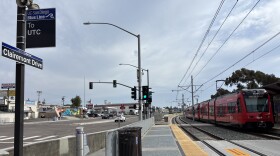San Diego County had an unusually cool spring and one of the coolest summers in decades. But the risk of wildfires could increase this winter, if we don't get more rain. Joining us on Morning Edition to talk about this is Jim Purpura, meterologist-in-charge at the San Diego Office of the National Weather Service.
Before we talk about rainfall this winter, how would you characterize the effect La Niña has had on weather conditions so far this year?
JIM PURPURA (National Weather Service): Well, I think we haven't really seen the full effects quite yet. Probably, La Niña -- which is characterized by the cooler-than-normal oceanic water temperatures in the eastern Pacific -- that is forecast to peak probably in the November, December timeframe. What we see in southern California, we have unreliably wet winters with El Niño. But the flipside of that -- La Niña produces generally reliably dry winters, so over the winter as a whole we're probably going to see below normal precipitation.
ED JOYCE (Host): Why do we use Spanish names to describe El Niño and La Niña?
PURPURA: El Niño is Spanish for "the Christ child." My understanding -- this was a phenomena with the ocean water temperature reversals that was first noticed off the coast of Peru in South America, and it was associated with something that would happen around Christmas in that area.
JOYCE: Jim, researchers at the Climate Prediction Center say La Niña could produce below-average rainfall in southern California this year. Have we seen any indication of that so far?
PURPURA: We haven't really seen the full effects yet. One of the interesting things that tends to happen in La Niña years -- not only is the rainfall below average, the variability is above average. In other words, what we're more likely to see when we do get the rainfall, we're likely to get it in intense periods of several days in a row, or we may actually have flooding, and even debris flows where there are burn areas. So that's kind of one of the ironies of La Niña seasons -- you tend to get it in a few short, sharp bursts. Overall, we think we're going to be below normal.
JOYCE: So, we're looking at an increased risk of wildfires, with dry weather and Santa Ana winds potentially kicking in as well?
PURPURA: See, that's going to depend on when the first wetting rains happen. If we get our first wetting rains early in the season, basically the Santa Anas or the offshore winds are not going to be too much of a problem. If our early fall rains are delayed into, say, November or December, then we could have a very long fall fire season.
JOYCE: And what role does climate change play, if any, in what we're seeing with the weather?
PURPURA: We think that we can't attribute any particular year of El Niño or La Niña in general to climate change, or particularly any particular storm. It's hard to trace that back to any one weather phenomenon being directly affected by climate change. We could expect to see some wetter years, stronger El Niños, and then more extreme fire seasons in the dry years.
JOYCE: And finally, how long does this weather pattern the La Niña usually last?
PURPURA: The peak is going to be November to December, and then we'll be mostly out of this weather pattern by the time we get into the summer next year. But the main effects of La Niña or El Niño in southern California happen during the winter months.
JOYCE: That's Jim Purpura, meteorologist-in-charge at the San Diego office of the National Weather Service.







